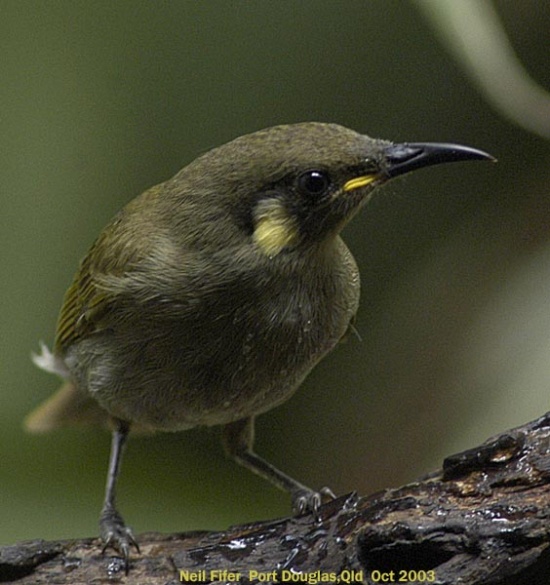
Port Douglas, Queensland, Australia, October 2003
This image was uploaded as Graceful Honeyeater but by range it falls into the new species, Cryptic Honeyeater
- Meliphaga imitatrix
Microptilotis imitatrix
Identification
15–17 cm
- Olive-grey upperside
- Entire underside almost equally dark
- Dull yellow gape
- Ear-spot usually with fussy peak at top
- Iris navy-blue when seen in perfect light
- Bill dark and slightly down-curved
Similar species
Graceful Honeyeater differs in pale rear underside, details of head ornaments, and eye color. Also compare with Yellow-spotted Honeyeater.
Distribution
Australia: North-eastern Queensland (Mossman to Burdekin River)
Taxonomy
This species was formerly included in Graceful Honeyeater.
This is a monotypic species[1].
Habitat
Woodlands, rain forest and forest edges.
Behaviour
Their diet consists of fruit, nectar and insects.
Vocalisation
Most common vocalizations are a plink call given at 2-3 second interval and a high pitch squeaking with about 4-8 notes given during 1-2 seconds.
References
- Clements, J. F., P. C. Rasmussen, T. S. Schulenberg, M. J. Iliff, T. A. Fredericks, J. A. Gerbracht, D. Lepage, A. Spencer, S. M. Billerman, B. L. Sullivan, M. Smith, and C. L. Wood. 2024. The eBird/Clements checklist of Birds of the World: v2024. Downloaded from https://www.birds.cornell.edu/clementschecklist/download/
- Paper describing the differences eventually leading to separation of Cryptic Honeyeater from Graceful Honeyeater
Recommended Citation
- BirdForum Opus contributors. (2025) Cryptic Honeyeater. In: BirdForum, the forum for wild birds and birding. Retrieved 12 May 2025 from https://www.birdforum.net/opus/Cryptic_Honeyeater
External Links
GSearch checked for 2020 platform.1



